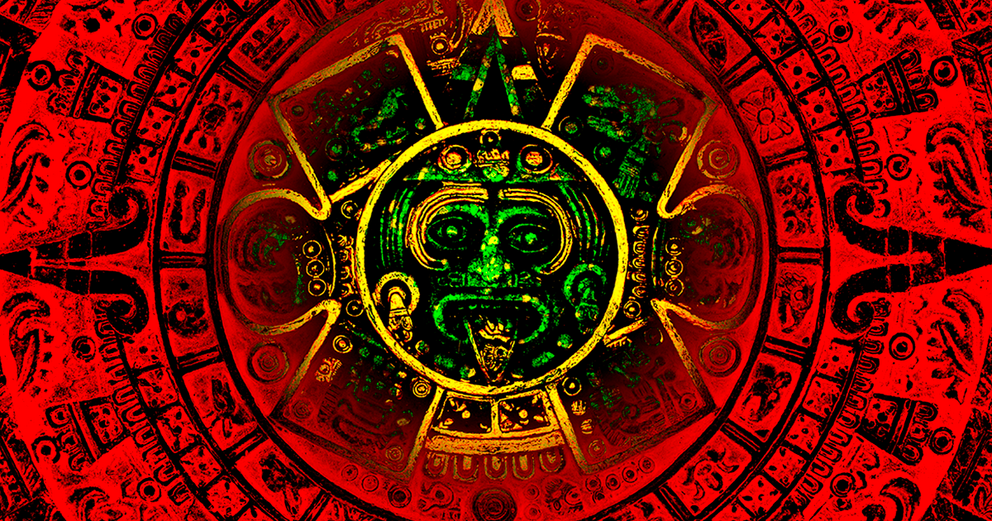New evidence sheds light on ancient Mayan calendar
Top image: Mayan calendar.
For years, scholars have been puzzled by the meaning of the 819-day count of the Mayan calendar in ancient glyphic texts. By examining the count over a 45-year period, researchers have discovered that it actually corresponds to the cycles of “all major planets.” It's an incredible example of the Mayan civilization's advanced astronomical knowledge, and a testament to the power of human curiosity and investigation.
The new research, published in the journal Ancient Mesoamerica has seemingly managed to answer questions that have confounded archaeologists and astronomers for decades. These findings offer a unique perspective on the intricate mathematics that underpin the complex Mayan calendar system. This research takes a broader view than any previous scientific investigation and provides new insights into the sophisticated astronomical knowledge possessed by the Maya.
 Close-up of glyphs on a Mayan calendar.
Close-up of glyphs on a Mayan calendar.
Unveiling the Secrets of an Ancient Synodic Tracking System
The two study authors, John H. Linden and Victoria R. Bricker, from Tulane University, explained that archaeoastronomical researchers had always struggled explaining the meaning behind the 819-day count in the Mayan calendar, that was only described in glyphic texts. It was always suspected that it was related to planetary cycles, but authors noted that “its four-part, color-directional scheme is too short to fit well with the synodic periods of visible planets.”
It is known that Mayan astronomers accurately calculated the synodic periods of visible planets, which refers to the time taken for a planet to return to the same position in the sky as seen from Earth. These ancient sky watchers used this knowledge to create calendars and to predict celestial events, such as solar and lunar eclipses. Venus's synodic periods were of particular interest to Mayan astronomers, but they tracked the motions of ‘all’ of the other visible planets, including Jupiter, Saturn, Mars and Mercury.
 The ancient Maya used their astronomical knowledge to create Mayan calendars and to predict celestial events such as solar and lunar eclipses.
The ancient Maya used their astronomical knowledge to create Mayan calendars and to predict celestial events such as solar and lunar eclipses.
Timeworn Patterns Emerge Within Mayan Calendar
Lead author, John Linden, found that when the Mayan calendar length is increased to 20 periods of 819-days, “a pattern emerges.” The calendar reveals the synodic periods of “all the visible planets” at station points in the larger 819-day calendar. In conclusion, the researcher concluded that the Maya took a “45-year view of planetary alignment,” and that they carefully encoded this into their calendar system.
Researchers have long held that this 819-day Mayan calendar was derived from the synodic periods of the visible planets. However, because each planet appears to follow a different track through the sky, matching up multiple planets into an 819-day span didn’t make any sense to early scholars. The new study shows, however, that the calendar is not only to be read over 819 days, but also over “16,380 days (about 45 years), a total of 20 times the 819-day count.
The pair of researchers began their study by analyzing the cycles of the planet Mercury, which has a synodic period of 117 days. This means Mercury completes exactly seven cycles within the 819-day count (819 / 117 = 7). Furthermore, Mars has a 780-day synodic period, therefore, 21 cycles of Mars equates to precisely 16,380. And, 20 cycles of the 819-day count also totals 16,380.
Having looked at all of the visible planets the researchers noted that seven periods of Venus match five 819-day counts, 13 periods of Saturn sync with six 819-day counts, and 39 periods of Jupiter equate to 19 819-day counts.
Digging Around the Heart of Mayan Cosmology
The two authors wrote that rather than limiting their focus to any one planet, the Mayan astronomers who created the 819-day count “envisioned it as a larger calendar system,” a tool that could predict “all the visible planet’s synodic periods.” Then, when the number 819 is extrapolated out 20 times, “you can fit every key planet into the mix.”
Having gained a rich understanding of how this lost Mayan calendar functioned, the pair of scientists found “commensuration points” with the planetary cycles in both the Tzolk’in and Calendar Round. Consisting of 20 periods of 13 days, the Mayan Tzolk'in was a 260-day calendar based on the corn growing cycle, which was used for divination and ritual purposes. The Haab’ was a 365-day solar calendar. The dates of the Tzolk'in and the Haab' are combined in the Calendar Round, and only repeated every 52 years.
The Tzolk’in and Calendar Round, and the newly discovered 819-day Mayan calendar, were all central in Maya cosmology, and they were used to dictate the key dates for all agricultural, religious and social activities.

